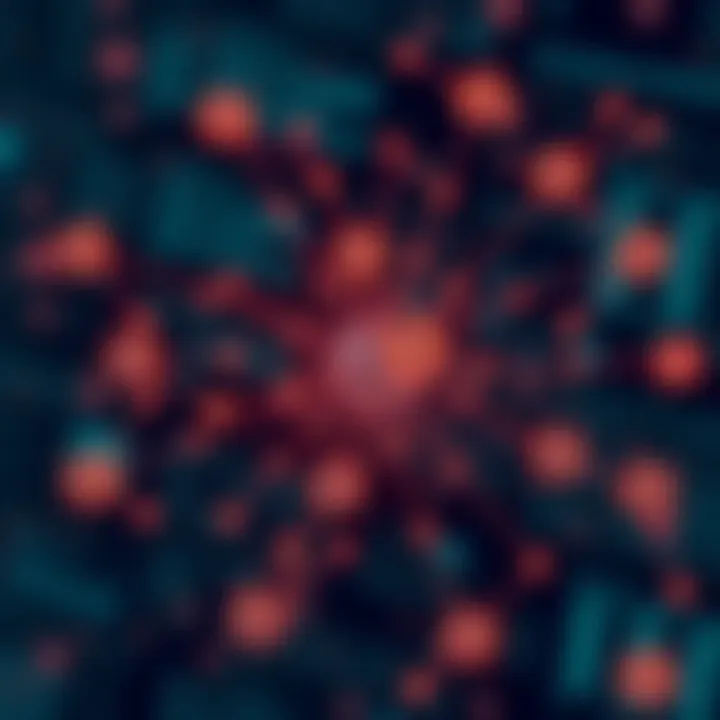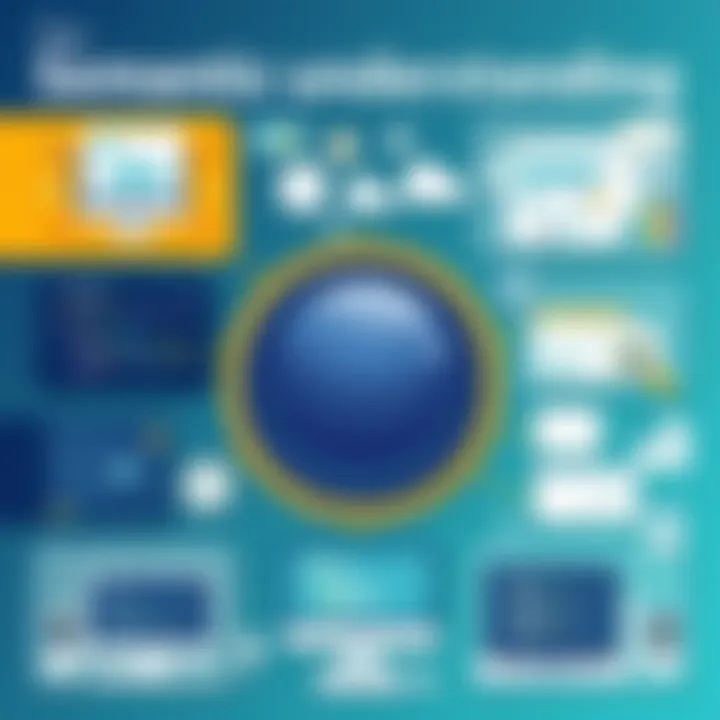Knowledge Graph Vendors: Insights and Trends


Intro
In today’s data-driven world, knowledge graphs have emerged as a cornerstone of modern data management and retrieval systems. As businesses strive to connect the dots between diverse datasets, they increasingly turn to advanced solutions offered by knowledge graph vendors. These solutions not only facilitate better data connectivity but also enhance the semantic understanding of information across various sectors. This guide unpacks the landscape of knowledge graph vendors, highlighting their unique offerings, the challenges they address, and which features set them apart in a crowded marketplace.
The development of knowledge graph technology has introduced a plethora of options for organizations looking to leverage data more efficiently. With the right knowledge graph vendor, businesses can expect to streamline their data processes and gain invaluable insights that propel decision-making. However, navigating this ecosystem can be challenging, especially for those new to the concept.
This article aims to serve as a well-rounded exploration of the field. From unpacking software offerings to evaluating user experiences, we will dive into the nitty-gritty of knowledge graph technology. By synthesizing user insights and expert opinions, we will provide organizations, whether small startups or large enterprises, with a comprehensive understanding tailored to their specific needs.
Let’s begin by exploring the software landscape and its essential features.
Intro to Knowledge Graphs
The significance of knowledge graphs has surged dramatically in recent years, as organizations increasingly harness the power of data connectivity and semantic understanding. Knowledge graphs serve as a foundational framework, enabling disparate data sources to communicate and interact fluidly. This is vital as businesses grapple with the complexities of vast, multifaceted datasets that span a myriad of sources.
Furthermore, knowledge graphs empower companies to extract actionable insights from their data, giving rise to a more informed decision-making process. Unlike traditional databases, knowledge graphs are about relationships and context rather than isolated data. They provide a more nuanced view of information, fostering enhanced comprehension and accessibility.
Incorporating knowledge graphs can lead to improved efficiency within organizations. By linking data in meaningful ways, knowledge graphs help streamline operations and reduce redundancies. This ability to visualize connections can illuminate opportunities and threats otherwise lurking in obscurity.
Defining Knowledge Graphs
A knowledge graph can be described as a structured representation of interconnected concepts and entities. These include everything from people and places to abstract ideas, all linked through defined relationships. Essentially, this graphical representation allows for better interpretation of data in a way that is intuitively understandable.
The backbone of a knowledge graph consists of triplets—these are simple statements composed of a subject, predicate, and object. For instance, a triplet may illustrate that "Alice (subject) loves (predicate) Bob (object)." This basic format helps build robust structures where complex associations can take form, facilitating advanced queries and analytics.
Historical Context and Evolution
Knowledge graphs did not just spring into existence overnight; rather, they evolved through a series of technological advancements. In the early 2010s, Google famously rolled out its Knowledge Graph feature, transforming the landscape of search engines. This initiative sought to enhance search results by understanding the intent behind queries rather than just matching keywords. Businesses quickly began to see the potential beyond search, recognizing the promise of these frameworks within their own data management processes.
Since then, knowledge graphs have expanded beyond their initial confines. Many industries have adopted this technology, customizing their graphs to fit specific needs. For example, in healthcare, knowledge graphs are utilized to link patient records, treatment options, and outcomes, creating comprehensive views that drive better patient care. In the financial sector, they support fraud detection efforts by mapping out intricate connections between transactions and entities.
Over time, advancements in artificial intelligence and machine learning have further catalyzed the evolution of knowledge graphs, enabling dynamic updates and improved inference capabilities. Businesses now face an ever-growing range of options, from open-source solutions to enterprise-grade products tailored to specific needs.
In summary, understanding the definition and historical significance of knowledge graphs is crucial for organizations aiming to utilize these tools. By leveraging their capabilities, firms not only optimize their data processes but also pave the way for innovative applications across diverse sectors.
Key Components of Knowledge Graph Technology
The foundation of knowledge graphs lies in their core components, each playing a pivotal role in shaping the functionality and utility of these systems. Understanding these key elements allows organizations to effectively leverage knowledge graphs for enhanced data management, semantic understanding, and decision-making. In this section, we will delve into three fundamental components: Data Integration, Semantic Representation, and Inference Mechanisms. Each is essential for tailoring knowledge graphs to meet specific business needs and drive value across various applications.
Data Integration
At its core, data integration involves combining data from different sources into a unified view. This is particularly crucial for knowledge graphs, which thrive on diverse datasets. Effective data integration means bringing together structured data, like that found in relational databases, and unstructured data, such as text documents or social media posts. The challenge is often in reconciling differences in the format or meaning of data across these sources.
- Benefits of Data Integration:
- Facilitates a richer understanding of information by correlating disparate datasets.
- Enhances the ability to conduct comprehensive analyses by merging datasets that previously existed in silos.
- Aids in maintaining up-to-date information, as integrated systems can pull in data in real time.
However, organizations must consider the technical and governance challenges during integration. Incompatibilities in data quality, schema designs, and even varying definitions can create significant hurdles. A robust data integration approach includes establishing clear data governance protocols, employing effective ETL (Extract, Transform, Load) processes, and utilizing APIs for seamless access to external data sources.
Semantic Representation
Semantic representation is the backbone of how information is structured within knowledge graphs. It provides a way to not only capture factual information but also to express relationships between data points. This is achieved through ontologies and schemas, which define how data entities relate to one another.
- Key Aspects of Semantic Representation:
- Enables machines to understand the meaning of data beyond mere keywords, enhancing search and querying capabilities.
- Increases interoperability by using standardized vocabularies, facilitating knowledge sharing across platforms.
- Supports more sophisticated queries, allowing users to explore relationships and connections that are not immediately apparent.
Without effective semantic representation, a knowledge graph risks becoming just another database, lacking the depth needed for meaningful insights. By employing technologies like RDF (Resource Description Framework) and OWL (Web Ontology Language), organizations can create a rich semantic layer that not only captures data but also provides a context in which that data can be utilized meaningfully.
Inference Mechanisms
Inference mechanisms empower knowledge graphs to draw conclusions and generate new insights based on the information contained within. Unlike traditional databases that solely return explicit data, knowledge graphs use inference techniques to derive implications from existing relationships. This capability is what sets knowledge graphs apart, transforming raw data into actionable knowledge.
- Types of Inference Techniques:


- Rule-based inference: Utilizes predefined rules to derive new information.
- Machine learning-based inference: Leverages algorithms to identify patterns and relationships not explicitly stated in the data.
Implementing effective inference mechanisms involves establishing a reasoning engine capable of processing rules and applying logical deductions. Organizations must balance the complexity of these systems with the computational resources available, ensuring that the solutions selected are scalable and can handle the volume of data being processed.
The interplay between data integration, semantic representation, and inference mechanisms forms the trifecta that enhances the ability of organizations to extract meaningful insights from their data, ultimately guiding smarter decision-making processes.
Understanding Knowledge Graph Vendors
Knowledge graph vendors play a pivotal role in today's data-centric landscape. As organizations grapple with massive amounts of information, sourcing the right solutions becomes crucial. Understanding what these vendors offer and how they operate allows businesses to harness the full potential of their data through meaningful connections and insights. Knowledge graphs serve not just as tools but as frameworks that enable companies to visualize complex relationships among data points. This facilitates not only data integration but also helps synthesize information into actionable intelligence.
Market Dynamics
The market for knowledge graph solutions is evolving rapidly. Companies are no longer satisfied with merely storing data; they seek to understand and manipulate it more effectively. When evaluating the landscape, one sees a mix of emerging players and established names, all vying for position in an expanding field. The demand for seamless data connectivity and semantic understanding drives innovation. This competitive environment leads to frequent updates and improvements, pushing vendors to refine their offerings.
Factors influencing market dynamics include:
- Rising Interest in AI: The integration of artificial intelligence adds a layer of sophistication, enabling improved analysis and insights from vast datasets.
- Industry-Specific Needs: Different sectors such as healthcare and finance have unique requirements, inspiring tailored knowledge graph solutions that address specific challenges.
- Collaborative Ecosystems: Today, many organizations prefer to partner with vendors that foster collaboration, enhancing their capabilities through joint innovation.
With technology changing at breakneck speed, businesses must keep a finger on the pulse of these market dynamics to remain competitive and informed about potential opportunities.
Major Players
In the world of knowledge graphs, a few key players stand out, shaping the direction of the technology while setting benchmarks for others to follow. Notable companies include:
- Google: Pioneered the knowledge graph with its search algorithms, enhancing user experience by introducing contextual understanding of queries.
- Microsoft: Their Azure platform integrates knowledge graphs to power applications that leverage data and insights seamlessly.
- IBM: With Watson, IBM has taken an innovative approach, allowing organizations to utilize graph technology in understanding complex relationships within large datasets.
The presence of these giants highlights the increasing importance of knowledge graph technology across multiple industries. However, it's not just the large players making noise. Startups and niche companies are also carving out market share with specialized services and offerings. For instance, companies focused on specific sectors like finance or healthcare are gaining attention by providing uniquely tailored solutions that answer pressing industry questions.
Understanding these major players is essential for organizations looking to partner with the right vendors, tapping into the best tools that fit their specific operational goals and data challenges.
"In an age where information is paramount, aligning with the right knowledge graph vendor can be the difference between navigating through data clutter and making informed decisions."
For more on knowledge graph innovation, check out resources such as Wikipedia and Gartner.
By grasping the nuances of vendor offerings and market dynamics, organizations can meaningfully enhance their data strategies, paving the way for effective decision-making.
Leading Knowledge Graph Vendors
In an environment where data drives decisions, leading knowledge graph vendors play a pivotal role. They bridge the gap between data silos, ensuring seamless access to interconnected information. Understanding these vendors is more than just knowing who they are; it's about appreciating the strategic advantages they can offer to various sectors.
Vendor Profiles
Vendor Overview
Vendor overview is essentially the snapshot of what a knowledge graph provider brings to the table. Each vendor has its unique flavor, operating protocols, and specific strengths that contribute to the larger ecosystem of knowledge graphs. For instance, Google’s knowledge graph shines for its impressive integration across multiple platforms—think search, ads, and Google Assistant. This interconnectedness is a substantial reason why it remains a front-runner in the field.
A key characteristic of a good vendor overview is clarity in functionality. A vendor that can clearly articulate its value proposition usually garners more attention and trust.
However, there's a downside as well. Some vendors may over-promise capabilities. Maintaining a balance in expectations versus reality is crucial for seamless implementation and user satisfaction.
Core Offerings
Core offerings resonate with the foundational tools and services a vendor provides. They encompass everything from data integration to analytical tools that help in extracting insights. A standout example is Neo4j, which offers a powerful graph database solution renowned for its ease of use and adaptability.
What's beneficial about such offerings is their flexibility, which allows organizations to scale their operations as their needs change. Neo4j's Cypher query language, for instance, gives users a simple way to traverse and manipulate data relationships. But beware: they also might require a dedicated technical team to manage.
Client Portfolio
The client portfolio showcases the scope and diversity of a vendor’s clientele. When a vendor can point to successful projects with known institutions, it often lends credibility. For example, the partnership between Grakn.AI and leading universities has showcased a robust way to manage complex datasets.
Such a diverse portfolio indicates the adaptability of the vendor's solutions. However, it might also mean that not every solution is applicable to your unique requirements. An organization must examine the nuances in the vendor’s experience relevant to their industry.
Comparative Analysis


Comparative analysis sheds light on how these vendors stack up against one another. It’s not just about features or pricing; understanding their unique selling propositions is crucial. For instance, consider the difference in focus: some vendors might prioritize scalability while others may lean toward user-friendliness. Mapping these traits onto your organizational needs helps in choosing the right partner.
Understanding the landscape of knowledge graph vendors enables businesses to harness the power of data more effectively. Identifying the right vendor is more than ticked boxes; it involves understanding each vendor's unique contributions to the tapestry of knowledge graphs.
Use Cases Across Different Industries
Understanding how knowledge graphs are applied across various sectors is crucial for organizations aiming to harness their power. Knowledge graphs play a significant role in linking complex data, providing a semantic foundation which enhances insights and decision-making. When tailored to specific industry needs, these graphs transform raw data into actionable knowledge, leading to improved outcomes and efficiencies.
Industry-specific applications not only highlight the versatility of knowledge graphs but also underline their value in integrating disparate data sources into cohesive frameworks. In this section, we will explore key use cases within the healthcare, financial, and retail sectors, underscoring their unique benefits and considerations.
Healthcare Applications
In the healthcare sector, knowledge graphs serve as an essential tool for facilitating better patient care, research, and operational efficiency. They allow for the integration of medical histories, treatments, and outcomes from various patients, creating a rich semantic network.
- Patient Data Management: By linking patient information with treatment protocols and outcomes, healthcare providers can derive insights on the efficacy of various treatments. For instance, hospitals can adopt knowledge graphs to manage patient records in a manner that each patient's unique health data is readily accessible and actionable.
- Disease Prediction and Prevention: Advanced analytics can be applied to data mapped in a knowledge graph, potentially leading to breakthroughs in predicting diseases. Algorithms can identify patterns that may indicate potential health crises.
- Drug Discovery: Companies like IBM Watson Health are leveraging knowledge graphs to sift through extensive biomedical literature and clinical trial data, unearthing connections that may pave the way for new drug discoveries.
"Knowledge graphs enable a new level of insight in healthcare, tying together diverse datasets that include genetics, patient history, and treatment efficacy."
Financial Sector Implementations
The financial sector is another domain where knowledge graphs shine brilliantly. They enhance data agility, risk management, and compliance efforts.
- Fraud Detection: By creating a comprehensive view of transactions and user behaviors, firms can more readily identify anomalies representing fraudulent activities. Knowledge graphs can reveal hidden connections between entities that might go unnoticed when analyzing data in isolation.
- Customer Insights and Segmentation: Banks and financial service providers utilize knowledge graphs to develop detailed profiles of their clients, ensuring more personalized services and product offerings. This level of understanding not only enhances customer satisfaction but also drives loyalty.
- Regulatory Compliance: Financial institutions face stringent regulatory oversight. Knowledge graphs help map the relationships between transactions, entities, and regulations. This visualization assists institutions in ensuring compliance with laws and regulations, as it makes tracking data lineage straightforward.
E-commerce and Retail
In the world of retail, knowledge graphs come into play in multiple ways, significantly enhancing customer experience and operational efficiency.
- Product Recommendations: Retailers like Amazon implement knowledge graphs to improve recommendation systems. They analyze not just what customers have bought, but what they searched for, viewed, or thought about, creating an interconnected recommendation network.
- Supply Chain Optimization: By connecting suppliers, products, and logistics, businesses can gain insights into potential bottlenecks and inefficiencies. For instance, if a product is delayed due to supplier issues, the knowledge graph can quickly identify alternative suppliers.
- Customer Experience Personalization: Retailers can utilize knowledge graphs to track customer interactions across all touches, combining data from in-store visits with online behavior. This allows businesses to offer personalized promotions and marketing based on customer preferences.
Evaluating Knowledge Graph Solutions
When it comes to leveraging knowledge graph technology, the evaluation of solutions is not just a minor step—it’s a crucial move. Understanding how to select the right vendor can save your organization from headaches and misalignment down the line. Whether you’re a small startup or a large enterprise, evaluating knowledge graph solutions lays the groundwork for effectively integrating and utilizing data across various platforms and disciplines.
Deciding on a vendor involves multiple elements that are essential for ensuring that the chosen knowledge graph plays well with existing tools and ultimately meets business goals. Factors like scalability, data security, and support features must be taken into consideration.
Furthermore, knowledge graphs can be complex beasts, inherently relying on a myriad of external relationships and data points. Thus, a strong evaluation process informs not only the successful deployment of a knowledge graph but also its adaptability to your organization’s changing needs.
Criteria for Selection
Choosing a knowledge graph vendor isn’t straightforward. Several criteria should be examined closely:
- Scalability: Can the solution grow with your needs? As your data expands or your business scales, the knowledge graph should be flexible enough to evolve.
- Integration Capability: Look for vendors that can seamlessly integrate with your existing systems, such as databases or analytics platforms.
- Usability: A user-friendly interface makes it easier for team members to engage with the graph.
- Support and Training: Evaluate the level of customer support and training that comes with the product. Strong support can mean the difference between successful implementation and run-of-the-mill failure.
- Cost Efficiency: Understand not just the initial costs but also any recurring expenses. Is it worth the investment against your projected return?
By considering these criteria, you’ll gain a clearer picture of the vendor’s worth.
Potential Pitfalls
Despite the positive impact that knowledge graphs can have on an organization, there are pitfalls to watch out for:
- Over-engineering: Sometimes, vendors offer overly complex solutions that may not align with your specific needs. Keep it simple.
- Ignoring Data Quality: A shiny graph is one thing; accurate and relevant data is another. Ensure the vendor prioritizes maintaining high standards of data quality.
- Vendor Lock-In: Be cautious of getting tied to a product that becomes nearly impossible to exit. Always check the terms carefully.
- Inadequate Testing: Failing to adequately test the system in a real environment can lead to unforeseen issues. Always seek a trial or demo to examine functionality hands-on.
"An ounce of prevention is worth a pound of cure." With the proper evaluation process in place, you can avoid pitfalls that others may have stumbled upon with their knowledge graph implementations.
For more in-depth readings on knowledge graphs, visit Wikipedia or check insightful reports available on Reddit.
Emerging Trends in Knowledge Graphs
The landscape of knowledge graphs is rapidly evolving, with trends that carry significant weight for organizations looking to harness their potential. Why are these trends important? Understanding them is crucial for positioning a business to capitalize on emerging technologies. Companies that stay ahead of the curve can transform their data strategies and streamline their operations.
Artificial Intelligence Integration
Artificial Intelligence (AI) has become a key ingredient in enhancing the capabilities of knowledge graphs. With AI integration, knowledge graphs can analyze vast amounts of data and detect patterns that might be invisible to human analysts. This capability brings several benefits:


- Enhanced Decision Making: By leveraging AI, businesses can make more informed decisions based on data-driven insights. AI algorithms can highlight correlations between data points and suggest actionable steps.
- Automated Data Updates: Knowledge graphs tied to AI systems can automatically update themselves as new data becomes available. This reduces time spent on manually curating data, ensuring that information is accurate and current.
- Natural Language Processing (NLP): Through AI integration, knowledge graphs can engage with users in a more intuitive manner. NLP can allow users to query the graph using natural language, making it accessible to a wider audience without requiring technical knowledge.
Taking steps to implement AI into knowledge graphs requires careful consideration. Organizations must assess their data quality and infrastructure. AI's effectiveness is only as good as the data it works with. Therefore, ensuring clean, structured, and relevant datasets is paramount.
Real-Time Knowledge Graphs
The demand for real-time data is surging. Businesses need information that reflects the most recent events to make timely choices. Here, real-time knowledge graphs come into play. They provide a framework for continuously updating information without significant delays. The importance of real-time knowledge graphs can be summarized as follows:
- Immediate Insight Generation: Real-time data means companies can respond promptly to market changes, customer behavior, or emerging trends. This agility can confer a competitive edge.
- Operational Efficiency: By continuously ingesting and processing data, businesses streamline their workflows. Operations become more efficient when data is always up to date, reducing decision-making lags.
- Enhanced User Experience: For customer-facing applications, real-time knowledge graphs enable personalized and relevant information delivery, improving user engagement and satisfaction.
However, developing a real-time knowledge graph comes with challenges. Organizations need robust data pipelines and infrastructure capable of handling constant data influx without hiccups. Security measures also must be in place to protect sensitive information.
"Harnessing emerging trends isn't just about technology; it's about rethinking how organizations can leverage data for meaningful impact."
Epilogue and Future Outlook
The conclusion of this examination on knowledge graph vendors is crucial as it synthesizes the fundamental insights gathered throughout the article. The evolving landscape presents a myriad of opportunities but also some challenges for businesses striving to leverage these technologies effectively. In an era where data plays a pivotal role in decision-making, understanding how knowledge graphs interconnect data sources and enhance semantic clarity is increasingly vital.
Consolidation of Knowledge Graph Vendors
As various vendors continue to innovate and expand their offerings, it's clear that mergers and acquisitions will shape the future of the knowledge graph market. Organizations may find that smaller niche players merge with larger entities, bringing specialized expertise into more expansive platforms. This consolidation could seek to eliminate redundancies, leading to more comprehensive solutions that are user-friendly and efficient.
- Strengthened Capabilities: When vendors merge, they can combine their different strengths, allowing for richer functionality in their products. This can lead to improved algorithms, better user interfaces, and enhanced customer support.
- Broader Market Reach: Larger vendors often have the resources to market their products more effectively, reaching new customers that smaller players could not. This is particularly relevant in sectors like healthcare and finance where robust data solutions are increasingly essential.
- Innovation Acceleration: A consolidated market can foster innovation as combined resources are channeled into research and development, pushing forward new features that cater to client needs.
"The future of knowledge graphs will be characterized by a blending of expertise and resources, driving a new wave of innovation."
These shifts require IT and software professionals to stay abreast of vendor developments. Understanding the direction in which these entities are headed will help businesses make informed choices when selecting their knowledge graph solutions.
Long-term Impact of Knowledge Graphs
Looking ahead, knowledge graphs are set to have a profound and lasting impact across various domains. The way businesses utilize knowledge graphs will not only change their operational capabilities but will also influence strategic decision-making processes.
- Enhanced Knowledge Management: In the long run, organizations that adopt these technologies will significantly improve their ability to manage information. As knowledge graphs evolve, they will become more adept at identifying relationships and insights from large datasets without requiring excessive manual effort.
- Integration with AI: The seamless integration of AI capabilities with knowledge graphs will enable real-time insights, fostering a proactive business environment that can swiftly adapt to market changes.
- Standardization and Interoperability: As the market matures, we can expect efforts towards standardization of knowledge representation. This will allow different systems and applications to interact with one another more effectively, increasing interoperability.
Ultimately, embracing knowledge graphs is more than just a technological upgrade; it signifies a strategic pivot towards data-driven decision-making. IT professionals, software engineers, and business leaders must recognize the importance of investing in this technology to secure a competitive edge moving forward.
By weighing current trends against future predictions, organizations can better position themselves to maximize the benefits of knowledge graph technology.
References and Further Reading
In the rapidly changing world of knowledge graphs, having the right references can make all the difference. This section emphasizes the vital role of quality references and further reading in bolstering one's understanding of knowledge graph technology. Beyond the foundational knowledge, access to credible resources can provide critical insights into evolving methodologies and innovations in the field.
Knowledge graphs are not static entities; they thrive on continuous learning and adaptation. Organizations that engage with research material and industry literature are better positioned to leverage these tools effectively.
Academic Journals
Academic journals are invaluable for professionals seeking to deepen their grasp of knowledge graphs. They offer peer-reviewed articles that cover the latest research findings and theoretical frameworks relevant to the field.
Benefits of engaging with academic journals include:
- In-depth Studies: Many journals publish extensive studies that detail case studies or experiments that underline successful implementations of knowledge graphs.
- Quality Assurance: Being peer-reviewed, articles found in credible journals ensure a certain standard of reliability and rigor.*
- Historical Context: Academic publications often provide a look back at where the technology has come from, offering lessons learned from past developments.
- Innovative Approaches: Researchers frequently propose new algorithms or methodologies that could inspire professionals to think outside the box.
Some notable journals include:
- Journal of Knowledge Management
- Artificial Intelligence Review
- Semantic Web Journal
Industry Reports
Industry reports are another essential component of staying informed about knowledge graph vendors and their technologies. These reports distill complex data into actionable insights that can guide business decisions. Often produced by research firms, they analyze market trends, vendor capabilities, and future projections.
Here are some reasons to rely on industry reports:
- Market Trends: They highlight the current state of the market, including shifts in vendor dynamics and emerging technologies.
- Comparative Analysis: Reports often include comparisons of various vendors, helping organizations make informed decisions when selecting a provider.
- Best Practices: By synthesizing insights from multiple sources, these reports can showcase best practices adopted globally, which may serve as a blueprint for implementation.
- Vendor Insights: Understanding a vendor’s market position and service offerings provides context when evaluating potential partners.
Key sources for relevant industry reports:
- Gartner
- Forrester Research
- Mordor Intelligence
"Reading widely provides not just knowledge, but a roadmap to where the industry is headed."







